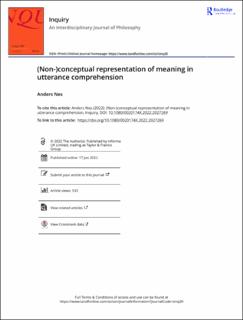| dc.description.abstract | Cognitivist, as well as many perceptualist, views of utterance comprehension agree that understanding an utterance involves knowing, believing, perceiving, or, anyhow, mentally representing the utterance to mean such-and-such. I dub such views representationalist. They have been criticised for placing an undue metasemantic demand on utterance comprehension: that speakers be able to represent meaning as meaning. Critics have adverted to young speakers, say about the age of three, who do comprehend many utterances but may be rather limited in their abilities to think about meaning as such, to cast doubt on this demand. This paper examines what the balance of developmental evidence and arguments shows, and identifies options for a representationalists response. Though there is some evidence that three-year-olds are curtailed in their abilities to think about meaning as such, they may yet turn out to have a concept of meaning, or at least some proto-semantic concept. Moreover, even if they lack any such concept, there is, I will propose, a way of developing representationalism, drawing inspiration from Davidson's paratactic view of indirect speech reports, on which meaning can be non-conceptually represented. Independently of developmental considerations, this proposal is of interest to friends of a perceptualist view of comprehension. | en_US |

